
Born in St Petersburg to a Ukrainian Jewish father and a Russian mother, Alexei Ratmansky grew up in Kyiv. After training at the Bolshoi Ballet Academy, he returned to Ukraine to dance with the Kyiv Ballet, where he met his wife Tatiana. Ratmansky danced in the west after the collapse of the Soviet Union, but returned to Russia as director of the Bolshoi Ballet from 2004 to 2008. He was artist in residence at American Ballet Theatre from 2009 to 2023, building his reputation as perhaps the best classical choreographer of our age.
He has been an outspoken critic of Russia’s invasion of Ukraine and branded a traitor by his former colleagues, although the Bolshoi continues to perform his works. In 2023, he became artist in residence at New York City Ballet. His Pictures at an Exhibition will be performed in London this month.
Would you make a ballet with music by a Russian composer now?
If I have a choice, I try to choose differently. Since the war started, I want to speak about Ukraine. I want to explore Ukrainian ballet history, listen to Ukrainian music, stage ballets connected to Ukraine. And I don’t want to mention or think about Russia. The horror of Russia’s deeds in Ukraine is just mind-blowing.
It must be difficult because you have a Russian as well as a Ukrainian history.
When I grew up, everything Ukrainian was considered second rate. During my time in Kyiv, I didn’t pay any attention to Ukrainian art or music. I was proud to be considered a Russian choreographer. It’s hard to believe I was so closed-minded and snobbish, and infected with this imperial attitude that only Russian culture has a value. It is embarrassing.
Since the war started, you have constantly celebrated Ukrainian culture and the bravery of the people — many dancers among them — who are fighting and who have died.
It’s my response to my own shortcomings. There was a moment when I thought, I can’t hide. All the Ukrainian companies continue performing. They lost half of their dancers, but they continue functioning. You can’t get a ticket because people need them. When there’s an air-raid siren, they go to the shelter with the audience and then continue the performance. They stage new ballets. Something quite extraordinary is going on in the art of Ukraine. It’s a rebirth of the nation.
All your family are still in Ukraine. How does that affect you?
You go to bed checking and check first thing in the morning, sometimes at night too if there is a missile attack. It is very hard. But I don’t live there; they do, and they don’t lose their sense of humour and they continue living. Three weeks ago, one of the principal dancers at the National Ballet of Ukraine posted a picture of himself holding his cat. Behind him, his apartment is completely destroyed. And he went to the theatre to continue rehearsing. That’s amazing.
How does it feel living in America and seeing Donald Trump meet Vladimir Putin in Alaska?
It’s a nightmare. It’s a betrayal of everything that made America beautiful. But I think it’s a good lesson. People start to understand that you can take nothing for granted. The biggest lesson I’ve learned since the war started is the fact that we didn’t pay the slightest attention to the tightening of Putin’s regime. It was so obvious, so clear. How could we all ignore it? For the first time living in America and casting my vote, I understood. It really depends on you. Your voice matters. If you don’t defend what you value — the democracy, the ideals — then it can be gone.
Should people boycott artists still working in Russia?
I think so. As an artist, you can’t be blinkered. You can’t hide. They always say don’t mix art and politics. The Russians love this excuse. But it’s almost like saying, don’t mix art and human values, don’t mix art and morality. It doesn’t work.
Yet you returned to create work for the Bolshoi after the invasion of Crimea in 2014. How do you feel about that now?
I feel really bad. I was repeating "art shouldn’t be mixed with politics" without understanding what it means, without thinking. It was wrong. Even though I’m proud of the ballets I staged, and they’re very much part of me, there are many of my ballets that I don’t want to be performed again, including The Bright Stream [his rethinking of a 1935 Soviet ballet set to Shostakovich]. Today it means the opposite of what I intended. The Bolshoi is still performing it without my permission; I plan to sue them.
Solitude, your 2024 ballet for NYCB, was inspired by a photograph of a Ukrainian man holding the hand of his 13-year-old son, who was killed by a Russian airstrike. Why did you want to make a ballet from that moment?
I live a life that is so safe and bourgeois. I need to constantly see the faces of people killed just to not lose a sense of danger. I didn’t know whether I could make the story work with ballet. Ballet wants to move away from the reality, to create ideal lines. But it was still important for me to make it.












